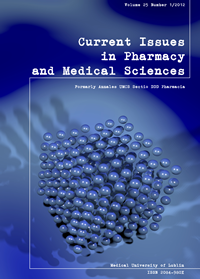Foreign body in the maxillary sinus – a case report
DOI:
https://doi.org/10.12923/j.2084-980X/25.1/a.03Słowa kluczowe:
maxillary sinus, foreign body, root canal overfilling, CBCTAbstrakt
Odontogenic myxoma is an odontogenic tumor of ectomesenchymal origin that is a locally invasive lesion that does not metastasize and appears slowly. It is thought to originate from the dental papilla, follicle, or periodontal ligament. Borders of this tumor may be well demarcated or ill defined. Radiographically, myxomas may resemble an ameloblastoma or a central giant cell granuloma. A biopsy is necessary to ascertain an accurate diagnosis. Recommended therapy varies from curettage to radical excision. However, complete surgical removal can be difficult. Due to the fact that this tumor has the potential for local invasion with a high rate of recurrence, radical surgery has been strongly recommended. This paper presents a case study of a 22-year old Caucasian woman with a tumor in the maxilla. This was totally removed using a transoral approach and partial excision of alveolar bone. The patient was followed up, and after five years, neoplasm recurrence was not found.
Bibliografia
1. Beck-Mannagetta J., Necek D.: Radiologic findings in aspergillosis of the maxillary sinus. Oral Surg. Oral Med. Oral Pathol., 62, 345, 1986.
2. Bodet Augusti E. et al.: Foreign bodies in maxillary sinus. ACTA Otorrinolaringol Esp., 60, 190, 2009.
3. Costa F. et al.: Endoscopically assisted procedure for removal of a foreign body from the maxillary sinus and contemporary endodontic surgical treatment of the tooth. Head and Face Med., 2, 37, 2006.
4. de Shazo R.D., Chapin K., Swain R.E.: Fungal sinusitis. N. Engl. J. Med., 337, 254, 1997.
5. Fugazzotto P.A.: A comparison of the success of root resected molars and molar position implants in function in a private practice: results of up to 15-plus years. J. Periodontol., 72, 1113, 2001.
6. Ishikawa M. et al.: Migration of gutta-percha point from a root canal into the ethmoid sinus. Br. J. Oral Maxillofac. Surg., 42, 58, 2004.
7. Khongkhunthian P. Reichart P.A.: Aspergillosis of the maxillary sinus as a complication of overfilling root canal material into the sinus: report of two cases., 27, J Endod., 476, 2001.
8. Liston P.N., Walters R.F.: Foreign bodies in the maxillary antrum: A case report. Austr. Dent. J., 47, 344, 2002.
9. Ludlow J.B., Ivanovic M.: Comparative dosimetry of dental CBCT devices and 64-slice CT for oral and maxillofacial radiology. Oral Surg. Oral Med. Oral Pathol. Oral Radiol. Endod. , 106, 106, 2008.
10. Pascon E.A. et al.: Tissue reaction to endodontic materials: Methods, criteria, assessment, and observations. Oral Surg. Oral Med. Oral Pathol., 72, 222, 1991.
11. Pogrel M.A.: Damage to the inferior alveolar nerve as the result of root canal therapy. J. Am. Dent. Assoc., 138, 65, 2007.
12. Rodrigues M.T. et al.: Chronic maxillary sinusitis associated with dental impression material. Med. Oral Patol. Oral Cir. Bucal., 14, E163, 2009.
13. Scarfe W.C., Farman A.G.: What is cone-beam and how does it work? Dent. Clin. North Am., 52, 707, 2008.
14. Varlan C. et al.: Current opinions concerning the restoration of endodontically treated teeth: basic principles. J. Med. Life., 2, 165, 2009.
15. Yaltirik M. et al.: Orbital pain and headache secondary to overfilling of a root canal. J. Endodon., 29, 771, 2003.
16. Yamaguchi K., Matsunaga T., Hayashi Y.: Gross extrusion of endodontic obturation materials into the maxillary sinus: a case report. Oral Surg. Oral Med. Oral Pathol. Oral Radiol. Endod., 104, 131, 2007.
17. Zitzmann N.U. et al.: Strategic considerations in treatment planning: deciding when to treat, extract, or replace a questionable tooth. J. Prosthet. Dent., 104, 80, 2010.
Pobrania
Opublikowane
Numer
Dział
Licencja
Prawa autorskie (c) 2012 Autorzy

Praca jest udostępniana na licencji Creative Commons Attribution-NonCommercial-NoDerivatives 3.0 Unported License.


